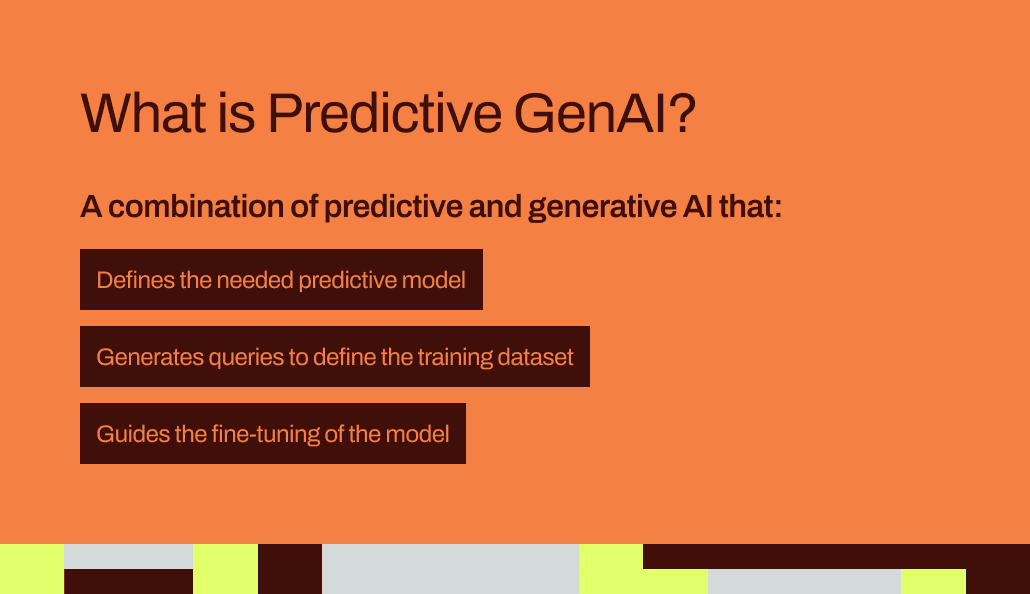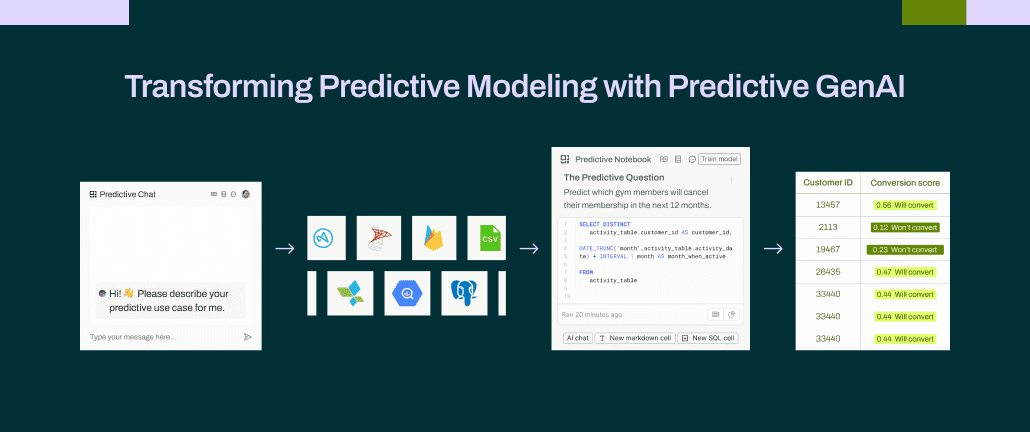Powering Up with Predictive GenAI
Sponsored Content
Salted caramel. Yin and yang. Rock and roll. Predictive AI and generative AI. They’re all combinations that make such a bigger impact when they’re put together than alone. And today, we’re here to explore that last combination: Pecan’s Predictive GenAI. What is it, and how will it reshape your AI experience?
Let’s explore the capabilities of Predictive GenAI and discover how it enhances the accessibility, efficiency, and impact of using predictive analytics in your business.

Defining Predictive GenAI
What Predictive GenAI means
Pecan’s Predictive GenAI combines predictive AI and generative AI. Predictive GenAI uses generative AI methods to support the predictive modeling process, including defining the needed model, generating an initial framework, and offering guidance in fine-tuning the model.
Predictive modeling refers to traditional machine learning methods that acquire information from training data and then use that analysis to make predictions with new data.
Consider a customer churn prediction model as an example. By analyzing historical customer data, machine learning algorithms can pinpoint patterns of behavior that often customer churn. Then, the model can examine current customer data to detect those same patterns, identifying individuals at risk of churning in the future.
Pecan AI has successfully helped many customers tackle that modeling task over the years. (These pioneers are getting a competitive edge, jumping ahead of the 61% of CEOs who aren’t yet even starting to explore predictive AI, according to McKinsey.)
While predicting customer churn is a commonly discussed use case for predictive analytics, even this example of predictive AI presents challenges. Even seasoned professionals may find it perplexing to choose the optimal approach — and something seemingly as basic as defining “churn” for a particular business can spark disagreements. The process of gathering requirements, establishing a shared understanding with the business, and manually coding to meet specific needs can be exceedingly time-consuming, demands specialized technical expertise, and brings a degree of risk.
As you can imagine, tackling predictive tasks in more specific industries or departments can be even more difficult. What if instead of predicting customer churn, you wanted to predict:
- Which of your city’s fleet of garbage trucks will break down in the next month, given their service records and mileage
- The time it will take for a meal delivery to arrive at your home based on weather, traffic, and restaurant selection
- The likely winner of arm-wrestling contests, given information on past competitions and the physical characteristics of contestants
These might be less common predictive tasks, but they could be incredibly useful for those who need to know those answers. However, it’s unlikely that you’ll find a pre-built tool that would help you build predictive models for these questions. As far as we know, no “arm-wrestling contest prediction software solution” is currently available on the market (but, hey, there’s a free startup idea for you).
So, whether you have a commonly shared business challenge like churn or a very niche issue, you face an uphill battle in building a predictive model to help solve it. Your options may feel limited: do you need to hand-code a solution? Hire a team of data scientists to take on the task, and brace yourself for six months to a year of waiting for a model that may or may not deliver on your actual needs?
Nope. Because Predictive GenAI is now here to help you achieve your predictive modeling goals, without needing to dive into coding or statistics yourself. With Predictive GenAI, you’ll arrive at accurate predictions more easily and far faster, a notable improvement on the tedious, slow processes of the past.
What Predictive GenAI can do
Whether it’s customer churn, truck maintenance, or anything else you need to solve with a predictive model, our Predictive GenAI is here to help. But what does the “GenAI” component bring into the picture?
As you’re probably aware, humans can have in-depth, insightful interactions with generative AI tools using plain natural language. Dialogues with GenAI can produce diverse creative outputs, including text, images, audio, synthetic data, code, and beyond. If you’ve ever bombarded ChatGPT with silly questions, you’ve experienced firsthand GenAI’s remarkable ability to handle the array of input that humans can provide.
Pecan’s Predictive GenAI transforms humans’ input into predictive modeling. Our Predictive GenAI capabilities make it possible to translate your business concern into a predictive model faster than ever — no matter how specific or niche your needs may be.
First, Predictive Chat will gather essential information about your goals and help you define a “predictive question” that your model can answer. Coming up with a question might sound like a relatively minor step in the process, but at Pecan, we’ve found it’s critical. For example, consider the customer churn model mentioned above. “Churn” for one business might mean they never hear from a customer again; for another business, it might mean a reduction of activity (but not a complete end of the relationship).
Defining these details as part of the predictive questions is like specifying the precise amount of ingredients for a recipe. Sure, water is part of your ingredient list for baking bread, but the amount of water makes an enormous difference in your final product.
Predictive Chat leads you through determining all of these critical ingredients to make it as easy as possible to create a successful predictive model. No guesswork required — you’ll know from the start exactly what you’ll be predicting and that it will be relevant to your business’s needs and goals.

Pecan’s Predictive GenAI provides fast, seamless predictive modeling
Then, you’ll move forward to a SQL-based Predictive Notebook experience that guides your next steps. Using GenAI, our Predictive Notebook is pre-filled with the SQL queries, so you don’t have to write them yourself. Just tweak them where needed to make any adjustments you’d like. You won’t have to struggle to parse out which fields are relevant, which tables to join and how, or which aggregations you’ll need.
Combining predictive and generative AI will lead to better business outcomes. Pecan’s Predictive GenAI introduces a powerful way to gain business value by combining these technologies.
How Predictive GenAI will transform your AI efforts
It’s not always easy for data analysts and businesspeople to translate their business concerns into actionable, well-defined predictive modeling tasks. Pecan’s Predictive GenAI now handles precisely that translation — from business need to predictive model. Its generative component can understand and pursue the necessary information about business needs.
With Predictive GenAI, there’s no more wondering: “Could we build a model to predict that?” The hassles of previous AI efforts are in the past. You won’t need to try to learn Python, recruit a data scientist to your team at the cost of $250K or more per year, or seek a consulting firm that might be able to grasp the nuances of your business.
Instead, just sit down for a simple chat and start your journey toward success with Pecan’s Predictive GenAI.
You can get started for free. We can’t wait to see what you’ll predict.